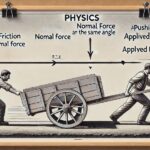Welcome to Physics Heaven! In this article, we will explore the intriguing concept of quantum mechanics linear potential and how it plays a fundamental role in quantum systems. Quantum mechanics is the foundation of modern physics, describing the behavior of particles on a microscopic scale. Among its many potential functions, the linear potential represents a scenario where the potential energy increases or decreases linearly with position. This concept is crucial for understanding various quantum phenomena, including quantum wells, harmonic oscillators, and even gravitational influences on quantum particles.
The Basics of Quantum Mechanics Linear Potential
In quantum mechanics, the potential energy function V(x) dictates how a quantum particle moves within a system. A linear potential is a potential energy function of the form:
where F is a constant force, x is the position, and V_0 is an initial potential energy reference. The quantum mechanical interpretation of this scenario involves solving Schrödinger’s equation for such a potential, leading to unique wavefunctions and energy eigenvalues.
Solving Schrödinger’s Equation for Linear Potential
To analyze a quantum mechanics linear potential, we must solve the time-independent Schrödinger equation:
For a linear potential V(x) = Fx, the solutions involve special mathematical functions such as Airy functions. These functions describe how a quantum particle behaves under a constantly increasing or decreasing force, similar to an electron in an electric field.
Applications of Quantum Mechanics Linear Potential
The quantum mechanics linear potential is applicable in various physical scenarios, including:
- Quantum Tunneling in Sloped Potentials
When a particle moves under a linearly increasing or decreasing potential, its probability of tunneling through potential barriers changes compared to traditional rectangular barriers. This is particularly useful in semiconductor physics and electronic devices. - Quantum Harmonic Oscillator Approximation
Although the harmonic oscillator has a quadratic potential, in certain conditions, it can be approximated using a linear potential for small displacements, providing insights into vibrational energy levels in molecules. - Electrons in an Electric Field
An electron moving in an electric field experiences a linear potential, making this model crucial for understanding Stark effect and field emission in solid-state physics. - Gravitational Quantum Effects
The influence of gravity on quantum particles can be studied using a quantum mechanics linear potential, particularly in neutron experiments where gravitational potential affects quantum states.
Airy Functions and Quantum Mechanics Linear Potential
For a quantum mechanics linear potential, the solutions to Schrödinger’s equation involve Airy functions, denoted as Ai(x) and Bi(x). These functions describe the probability distributions of quantum particles in a sloped potential and have been observed in experimental settings such as cold atoms in optical traps.
Physical Interpretation
The key takeaway from these solutions is that a quantum particle under a linear potential does not have discrete energy levels like in a harmonic oscillator but exhibits a continuous range of allowed energy states. This characteristic is crucial in analyzing quantum transport and field-induced transitions.
Experimental Studies on Quantum Mechanics Linear Potential
Numerous experiments have validated the theoretical predictions of quantum mechanics linear potential, including:
- Neutron Interference Experiments
Neutrons moving in Earth’s gravitational field have been shown to follow wavefunctions predicted by Airy functions. - Quantum Transport in Semiconductors
Studies of electron motion in electric fields confirm the theoretical behavior expected in a linear potential. - Optical Lattices and Cold Atom Traps
Cold atoms subjected to linear potential gradients display quantum states similar to those predicted by Airy functions.
Importance of Quantum Mechanics Linear Potential in Modern Physics
Understanding quantum mechanics linear potential is fundamental in many cutting-edge areas of research:
- Quantum Computing
Potential gradients play a role in quantum bits (qubits) control and manipulation. - Semiconductor Devices
Linear potential models help in designing transistors and quantum dots. - Gravitational Quantum Mechanics
Investigating how quantum particles behave under gravitational fields enhances our understanding of quantum gravity.
Conclusion
At Physics Heaven, we strive to make complex physics concepts accessible. The quantum mechanics linear potential is a crucial concept in quantum mechanics, explaining how particles behave under a continuously varying force. By solving Schrödinger’s equation for a linear potential, we gain insights into real-world applications such as semiconductor physics, electron motion in electric fields, and even quantum effects under gravity.
The study of quantum mechanics linear potential continues to be a significant research area, bridging the gap between fundamental quantum mechanics and applied physics. Whether in theoretical physics, quantum computing, or nanotechnology, this concept remains at the heart of quantum advancements.






